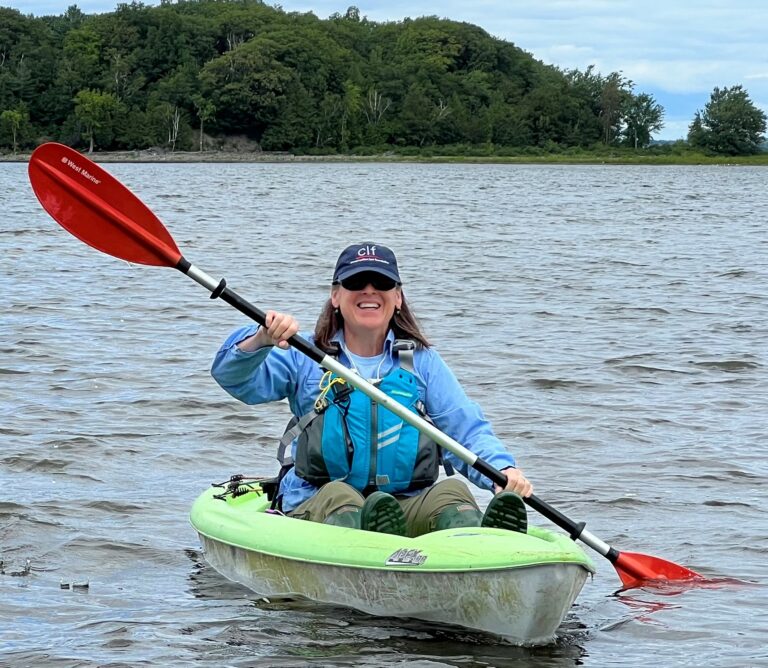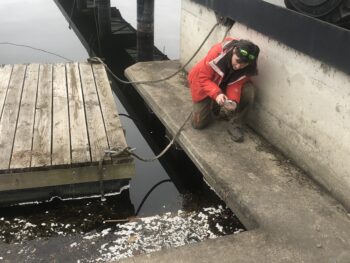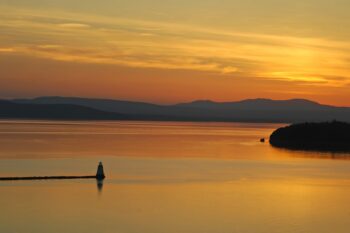Who Is Waterkeeper: Julie Silverman, Lake Champlain Lakekeeper
By: Thomas Hynes

Throughout the world, large bodies of water contain within them a bit of mythology. Humans can’t breathe under water. We can’t see or ever truly know what’s below the surface. Lakes, rivers and ponds have always been fertile ground for legends of monsters and other mysterious creatures.
Lake Champlain — which straddles the border between Vermont, New York State, and Canada — is no exception. Champy is the name of the Lake Champlain monster. Sightings of Champy predate the arrival of the Europeans. The Abenaki referred to the lake monster as “Gitaskog” and warned French explorers, including Samuel de Champlain, the lake’s namesake, who claimed to have spotted the mythical critter himself. There have been hundreds of sightings since. Champy can also be found on t-shirts and other memorabilia. Champy is also the inspiration for the local baseball team, the Vermont Lake Monsters, as well as their mascot.
The real danger lurking in the waters of Lake Champlain is not some imaginary sea serpent, but rather a dangerous combination of rapid development, agricultural consolidation, and climate change. These threats can take the form of cyanobacteria outbreaks, biodiversity loss, or even historic flooding.
Lake Champlain is the sixth largest body of freshwater in the United States. The lake sits at the northwestern corner of New England, nestled between the Adirondack Mountains to the west and the Green Mountains to the east. The full watershed is over 8,000 square miles and is home to roughly 600,000 people, nearly half of whom draw their drinking water from the lake. 
That’s what makes the work of Lake Champlain Lakekeeper Julie Silverman so critical. Housed within Conservation Law Foundation, an advocacy group working to protect New England’s environment for the benefit of all people, Lake Champlain Lakekeeper has been advocating for the wellbeing of this incredible natural resource for 20 years.
Julie has been on the job for about a year and a half, but she has been a Vermonter – and lover of Lake Champlain – for most of her life. Originally from New York, her parents moved the family to Vermont when she was young. Once the family got over the shock of cold winters and inadequate bagels, they quickly came to love their new outdoors lifestyle. She quickly learned to swim, sail, and fish, with many happy memories including both a snorkel and a mask.
In 2003, Julie was living in the Boston area, but moved back home to Vermont to open ECHO, Leahy Center for Lake Champlain, with a mission to inspire and engage families in the joy of scientific discovery, wonder of nature, and care of the lake. Julie spent years at ECHO educating the community and working for the lake’s wellbeing.
“It became really clear to me that I had to engage beyond education,” says Julie. “What’s the point of this gem if you can’t swim in it, or feel good boating in it?”
As Lake Champlain Lakekeeper since 2022, Julie has taken a more active approach to stewardship, monitoring the water and working on legislation. The role has allowed her to make systemic change, not just person-to-person issues about how everyone can make a difference. Rather this role has let her take on the ‘big ugly changes’ that need to happen.
“When you advocate for something that you love,” says Julie. “It’s really easy.”
It’s good that she loves the work, as there is certainly enough to keep her busy. The lake’s watershed is fairly rural, but has developed rapidly over the last few decades. Julie mentions how the interstate highway wasn’t completed in the area until 1982. Similarly, the idea of beach closures or unsafe water would have been a foreign concept to people in the area back then. Today it’s a sad reality. 
“It’s all about the land. Whatever happens on the land is going to make it into the water. It’s almost like every drop of rain has a little backpack and whatever it hits, it picks it up and carries it to the lake. It brings chemicals, toxins, human waste, pesticides, oil from your car,” says Julie. “All the towns, all the farms need to keep water where it lands and not push the problem downstream. It’s bigger than rain gardens. It’s about protecting wetlands and reconnecting water to the floodplain so the water can slow down and spread out.”
Runoff is always a problem in the Lake Champlain watershed, but the recent storms and floods in Vermont were a uniquely destructive series of events. According to Julie, the lake received about a year’s worth of phosphorus in barely two weeks. These types of floods are becoming more and more common, thanks in large part to the biggest threat facing the lake: climate change.
“It’s like somebody has taken the dial and turned it up to 11,” says Julie. “We have cranked up the temperature of the air and the water. We have cranked up the storm extremes. We have created insane rain events that turn into flash floods which turn into runoff.”
The recent floods didn’t just throw the lake out of whack, they also upended people’s lives. The water didn’t just wash out phosphorus, nitrogen, and other pollutants, it also took people’s possessions, mostly from low-income communities. It revealed an environmental justice issue. To that end, Lake Champlain Lakekeeper, with its parent organization Conservation Law Foundation, is continuing its environmental justice policy advocacy to address these concerns by helping low-income communities gain access to resources for climate resilience.
Julie’s work at Lake Champlain Lakekeeper is about protecting the lake for all those who depend on it. And that goes for humans and animals, alike, even the critters whose existence hasn’t technically been proven yet. Look no further than Champy, the lake monster. If ever discovered to actually exist, the sea serpent will automatically have legal protections in Lake Champlain, and an accomplished advocate in Julie.